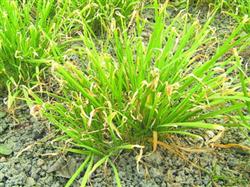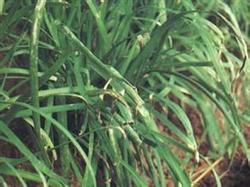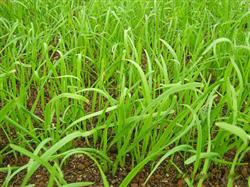Diagnosis and Control of Botrytis cinerea in Chinese chives

How to control gray mold of leek in greenhouse, which is also called "white spot leaf blight" and "white spot rot", is the main disease of leek in greenhouse, which should be prevented in advance to reduce loss and increase benefit. The occurrence conditions and control methods of Botrytis cinerea in Chinese chives are briefly summarized as follows: first, the occurrence conditions 1. Botrytis cinerea is closely related to the temperature and humidity in the greenhouse. The suitable temperature for pathogen transmission was 15-30 ℃, and the suitable temperature for mycelium growth was 15-21 ℃. Sclerotia was produced at high temperature. The relative humidity is 85%. When the relative humidity is more than 95%, the disease is serious, and less than 60% is mild or non-pathogenic. 2. Botrytis cinerea of leek is related to the environment in the greenhouse. When the shed room is suddenly cold and hot, the low temperature is frozen at night, the leek is frozen by high temperature, high humidity or bottom wind during the day, the temperature difference between day and night is too large, and there are water droplets in the leaves at night, resulting in the aggravation of the disease. 3. Botrytis cinerea of leek is related to disease resistance. First, the disease resistance of the variety itself is poor; second, the microclimate in the shed has not been effectively controlled, and the bad environment affects the disease resistance of leek, resulting in disease. 4. Botrytis cinerea of leek is related to the level of management. Insufficient fertilization in vegetable fields, especially insufficient application of phosphorus and potassium fertilizers, weak plant growth and reduced disease resistance; flood irrigation, resulting in excessive humidity in soil and shed, causing diseases; untimely ventilation or direct attack of cold wind at the bottom of the shed, aggravating the occurrence of the disease. Second, prevention and control measures 1, temperature control and humidity reduction. According to the change of the weather, open the greenhouse film appropriately at noon for ventilation and humidity reduction. The temperature in the shed is controlled by ventilation, so that the maximum temperature in the shed does not exceed 25 ℃, the maximum temperature of chives cannot exceed 23 ℃, the temperature difference between day and night cannot be more than 10 ℃, and the relative humidity in the shed should be controlled below 75%. Pay attention to the addition of aprons at the bottom of the shed, and it is strictly forbidden to let out the wind at the bottom. 2. Strengthen the management. First, select improved varieties and select excellent varieties with strong disease resistance when sowing; second, apply sufficient base fertilizer, which is mainly based on fully mature high-quality organic fertilizer, appropriately increase the application amount of phosphorus and potassium fertilizer, and combine with the application of medium and trace element fertilizers; third, water reasonably, popularize microtubule, drip irrigation or infiltration irrigation, and avoid flood irrigation; fourth, we should pay attention to timely and appropriate ventilation and humidity drainage, temperature regulation, and reduce foliar condensation. Fifth, 0.3% 0.4% potassium dihydrogen phosphate solution should be sprayed during the growing period to promote the robust growth of leek plants and enhance disease resistance. 3. Clean the shed. After the leek is harvested, the diseased leaves and plants should be removed in time, and the remains of the diseased plants should be burned or buried out of the shed to prevent the spread of germs. Combined with post-harvest fertilization to carry out mid-ploughing, loosen the soil, remove soil moisture and prevent stubble susceptibility. 4. Chemical control. In the early stage of the disease, timely use of drugs for prevention and treatment. After each harvest, spray medicine to prevent the disease.
- Prev

Control methods of Botrytis cinerea in Chinese chives
The protected land was fumigated with 10% Sukeling fumigant, 250g per mu, and foliar spraying with 50% Sukeling wettable powder powder 1000 times, 2% Wuyimycin (BO-10) 150x, 40% Botrytis cinerea 500-800x, 10% Polaroid 500-700x, 50% Nongliling 1200-1400 times.
- Next

Tips for dry sowing chives
1. Seed selection: according to local cultivation methods, cultivation purposes, climatic conditions, consumption habits and market demand, excellent leek varieties with marketable, disease and insect resistance, strong stress resistance and good commercial quality can be selected. The quality of seeds meets the requirements of GB8079. Refuse to use genetically modified leek varieties. 2. Seed treatment:.
Related
- Where is it suitable to grow horseradish in China? it is expected to see the middle altitude horseradish in Alishan.
- How to prevent tomato virus disease reasonably? (Control methods included)
- Many people like to plant towel gourd on the balcony. What are the main points of this method and management?
- What crops can chili peppers be mixed with?
- Fertilization techniques and matters needing attention in Tomato
- What are the grafting techniques for peach seedlings in spring?
- Harm and control methods of root swelling disease of Chinese cabbage
- What are the pests of sweet potatoes? How to prevent and cure it?
- Symptoms, causes and Control methods of navel Rot in Tomato
- The cause of "Cucumber rotten bibcock" in Farmers' planting Cucumber and its Control Plan

